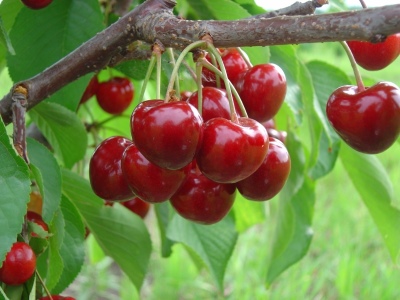
- Fruit shape: rounded oval
- Authors: T.V. Morozov (All-Russian Research Institute of Horticulture named after I.V. Michurin)
- Growth type: medium-sized
- Appointment: universal
- Yield: high
- Crown: rounded oval, raised, medium density
- Fruit size: above average
- Fruit weight, g: 5,5
- Fruit color: dark red
- Pulp color : Red
Sweet cherry Michurinka is a frost-resistant variety that attracts the attention of gardeners with high yields and tasty fruits. The tree is in demand in many regions of the country.
Breeding history
The breeding of the variety was carried out by domestic scientists who conducted selective experiments to obtain cherries with the best characteristics. The result of such experiments was the Michurinka cherry, whose history began in 1994.
Description of the variety
The variety has two subspecies: early cherry and late cherry.
Standard features of each option:
- average height;
- height 3-4 meters;
- crown of medium thickening and rounded oval shape;
- thick and straight shoots;
- large leaves of an oval shape and a green tint;
- white flowers, collected in inflorescences.
The tree forms medium-sized buds. The petioles of the leaf plates are of small thickness, they are neatly attached to the shoots.
Fruit characteristics
Sweet cherry pleases with large drupes, the average weight of which reaches 5.5 g.
Fruit characteristics:
- round-oval shape;
- dense, dark red skin;
- juicy, medium density pulp.
The fruits withstand transportation well, retaining their original appearance after picking. Suitable for fresh consumption and preparation of various jams, sauces and other preparations.
Taste qualities
Juicy and tender pulp pleases with a dessert taste with a slight sourness at the end. The fruits emit a pleasant aroma even during the formation process.
Ripening and fruiting
A medium-sized variety becomes capable of bearing fruit 5-6 years after planting. The tree begins to produce its first fruits towards the end of July.

Yield
The first two years after entering fruiting, the variety forms a small number of fruits, but then the yield begins to grow. The maximum figure reaches 30 kg per tree.
Self-fertility and the need for pollinators
Sweet cherry Michurinka is a self-fruitless variety. Therefore, it is recommended to plant a tree with other varieties of cherries: Bryanochka, Veda, Tyutchevka, Pink Pearls, Michurinskaya late.
Growing and care
Planting Michurinka cherries does not require much effort and time, since the variety is rather unpretentious. But in order to achieve a bountiful harvest, it is worth considering a few recommendations.
- Sweet cherry prefers to grow in well-lit areas, where there is practically no shade and drafts.
- You should not plant a tree in lowlands, where there is a risk of accumulation of melt water. If there are no other areas, it is worth providing a drainage system, otherwise the water will destroy the plant.
- The distance between plantings should be 2 meters for the seedlings in a row and 3 meters for the rows themselves.
- Better to plant trees in sandy loam or sand. The variety does not like clay and loam and quickly dies in such soils.
- Other varieties of cherries that are recommended to be planted nearby will help ensure rapid growth and pollination of the plant.
- It is better to plant a crop in spring. However, in the southern regions, you can give preference to the autumn season.
Before you start planting trees, it is worth preparing the necessary materials and tools, including:
- shovel;
- rake and hoe;
- fertilizers;
- water;
- peg;
- seedling.
When choosing the latter, preference should be given to two-year-old samples without defects on the bark and leaves. The landing algorithm is as follows.
- The seedlings are preliminarily grafted. Also at this stage, pits are dug up to a depth of 40-50 cm, where a layer of fertilizers is then spread.
- A week before planting, the holes are loosened, saturating the soil with oxygen.
- Upon reaching the required period, the seedlings are moved into the holes, where the pegs are installed in advance.
- The trunk is tied to the stake, and the roots are covered with soil, gently ramming. After it is watered abundantly.
Caring for the variety does not require much effort. The standard procedures are as follows.
- Watering. You need to add water once a month. Young seedlings will need 3-4 buckets for active growth, fruit-bearing trees - from 5 to 6.
- Top dressing. You can start applying fertilizers in the second year. Urea is used as top dressing in the autumn, while superphosphate is given in the spring.
- Pruning. In the first years, the procedure is performed to form the crown. Afterwards, they carry out sanitary pruning, removing dry and old branches.
Also, in the northernmost regions, trees are prepared for winter by digging up soil around the trunk and carefully fertilizing it with organic matter.





Requirements for soil and climatic conditions
The Michurinka variety is able to withstand fairly strong frosts, therefore, the plant is planted in the northern and central regions. Gardeners recommend covering the plant additionally in order to preserve the quality of the harvest in the future.
Sweet cherries also tolerate droughts well and can be planted in southern regions.In addition, hot climates have been shown to have a positive effect on fruit abundance and quality.
































































